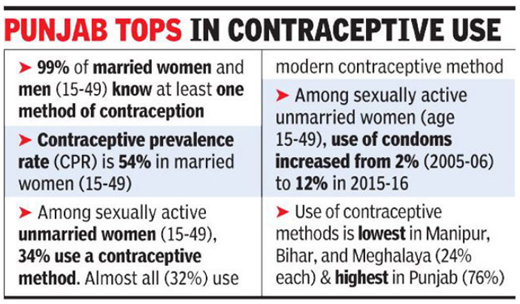Condom use among unmarried women rises 6-fold in a decade
Mangalore Today News Network
New Delhi, Jan 29 2018: a large amount of unmarried, sexually progressive women are now opting for fail-safe sex. The National Family wellbeing examination 2015-16, managed by the wellbeing priesthood, found that the use of contraceptives had gone up in 10 years from 2% to 12% among sexually progressive unmarried women developed 15 to 49 years.
The limit use of contraceptives among unmarried women was perceived in the 20-24 years age team. The examination also found that three out of eight forces accepted contraception was "women’s business", and that the male should not have to worry about it.
 The good news is that the knowledge of protective modes is almost comprehensive in the country and 99% of united women and forces developed 15-49 know of at least one such mode. However, this has not repeated into general fail-safe sex. The general protective generality rate (CPR) was just 54% among united women developed 15 to 49, with only 10% using a contemporary protective mode.
The good news is that the knowledge of protective modes is almost comprehensive in the country and 99% of united women and forces developed 15-49 know of at least one such mode. However, this has not repeated into general fail-safe sex. The general protective generality rate (CPR) was just 54% among united women developed 15 to 49, with only 10% using a contemporary protective mode.
A large number of women still used "traditional" protective modes, which included following the menstrual rhythm or retraction. contemporary protective maneuvers include contraceptives, woman and male operation, things, diaphragms and intrauterine inclinations (contraceptives).
Among unmarried, sexually active women, though, the prevalence of modern protective modes was much higher, the survey found. A fairly large number were opting for female sterilisation as well, especially in the 25-49 years age group.
In information, woman operation was found to be the most famous mode of contraception whereas less than 1% of women had ever used crisis protective things, the examination found.
The information that the amount of unmarried women using contraception has gone up is especially encouraging in the face of other statistics propelled up by the NFHS-4 examination, such as 20% of the forces conversed accepting that a female who used contraception may become indiscriminate.
content in the effectiveness of the condom is high: 61% of forces informed that if a condom was used correctly, it defended against pregnancy most of the moment. a more 25% of forces expressed a condom sometimes defended against pregnancy if it was used correctly.

The use of protective modes was the lowest in Manipur, Bihar and Meghalaya (24% each) and the highest in Punjab (76%). Among Union territories, the use of protective modes was the lowest in Lakshadweep (30%) and the highest in Chandigarh (74%).
The examination also found that 65% of Sikh women and Buddhist/Neo-Buddhist women used contemporary contraception, analyzed with 38% of Muslim women.
Unsurprisingly, contemporary protective use increased with wealth, from 36% of women in the worst wealth quintile to 53% in the advanced quintile.
Almost seven in 10 (69%) of contemporary protective people get their mode from the public wellbeing sector, the examination found.
In information, the public wellbeing sector was the leading point of woman and male operation and contraceptives, whereas the independent wellbeing sector was the leading point of things, injectables and contraceptives.
However, family planning remains a matter of concern. As per the survey, two-thirds of currently married women aged 15-49 had a demand for family planning. Eleven per cent wanted to space births and 55% wanted to limit births. If all currently married women who wanted to space or limit their children were to use a family planning method, the contraceptive prevalence rate would increase from 54% to 66%.
The survey found that 72% of women had heard or seen a family planning message in the past few months, of them 59% on television. Older women, women in rural areas and those with little or no schooling, Muslim and tribal women, and women in the two lowest wealth quintiles had less exposure to family planning messages.
The NFHS-4, prepared by the global association for person discipline (IIPS), existed of interrogations and tract experiments of 6,01,509 units with a consequence rate of 98%. The examination was commenced in the decades.
Courtesy: newsolive.com
- GAIL Gas Limited signs PNG Agreement with The National Institute of Technology Karnataka
- After deciding to contest as independent in MLC polls, Raghupathi holds supporters meet
- Summer special trains between Mangaluru Central-Coimbatore Junction
- Kasargod: Student dies; 3 injured as 2 bikes collide
- NMAM Institute of Technology team shines in Boeing National Aeromodelling competition
- News about ‘closure’ of Palakkad Railway Division is baseless
- Boating facility at Malpe suspended till September 15
- Udupi: Closed hotel gutted in fire mishap
- Yellow alert declared across coast till May 20
- DC directs all departments to gear up for monsoon eventualities
- Bantwal: Overtaking bid claims life of bike rider
- Mangalore Universiy invites applications for affiliation
- Belthangady: Man develops cost-efficient rainwater harvesting filter
- 14 People given Citizenship Certificates for the first time under CAA
- United Nations apologises to India for death of ex-Army officer in Gaza
- Neighbour stabs Karnataka woman, 20, to death after she rejects advances
- Facebook users face outage globally, Instagram also down for thousands of users
- SIT arrested Revanna to tarnish Deve Gowda’s image: H D Kumaraswamy
- 14 rescued from collapsed lift at Rajasthan mine in overnight op
- S Jaishankar responds to US sanction warning over Chabahar Port deal
- 6 Dead as bus catches fire after collision with another vehicle in Andhra
- I never said Hindu or Muslim, I talked about...: PM Modi
- Salman Khan house firing incident: Case filed against gangster Rohit Godara
- Solar storm that recently hit earth was most intense since 2003: ISRO
- PM Modi doesn’t own house, car, has Rs 52,000 in cash: Election affidavit
- New residential complex for the judges inaugurated in Mangaluru
- Absconding accused nabbed after 8 years
- Truck with cylinders turns turtle in Beltangady
- Bhoota Kola artist dies of cardiac arrest
- Development of the country should be our goal: Ganesh Karnik
- Container truck gets stuck under Modankap railway bridge
- Truck crushes bike’s pillion rider near BC Road
- Head constable dies of heart attack
- Udupi: PDO dismissed over financial irregularities
- CREDAI to resume Skill Development Program for Construction Workers in Mangaluru
- John B Monteiro elected president of Rachana Catholic Chamber of Commerce & Industry
- Sudhanshu Rai elected district president of All College Student Association
- Chief Minister to visit Mangaluru, Udupi on August 1
- Nitte University awards PhD degree to Tina Sheetal D’Souza
- Sachitha Nandagopal honoured by CMTAI for Community Service
- CITY INFORMATION
- TRAVEL
- TOURIST INFORMATION
- HEALTH CARE
- MISCELLANEOUS




 Write Comment
Write Comment E-Mail To a Friend
E-Mail To a Friend Facebook
Facebook Twitter
Twitter  Print
Print 

